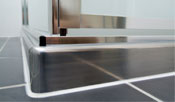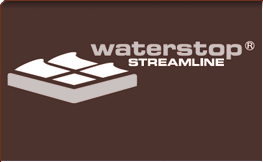| Data Sheet |
| Installation Instructions |
| Trouble-free Showers |
| Best Practice Construction |
| Current Industry Issues |



Choosing a Waterproof Shower Membrane System? Manufacturer Supplies Premier Waterproofing Bathroom Products
When it comes to bathroom construction or remodelling, choosing a waterproofing membrane system requires a lot of consideration. The quality of waterproofing materials will greatly influence how well the seal holds over time. It is also important that your materials are compatible with one another. In particular, the seal and screen system must be compatible with the membrane.
Contact UsSee the Benefits of using Waterstop Streamline »
Waterproof Membrane Bathroom Materials
The membrane is a key material in of bathroom waterproofing. Membranes are made from a variety of materials, though most recent technology tends to involve polymer-based materials. This rubbery product is laid-out below shower floors to prevent water from escaping. Layers of tile and other materials are placed above the flat membrane surface.
Are you looking to start waterproof membrane bathroom installation? Membrane products come in many different styles. Some are rubber sheets that need to be rolled out and attached to the surface, while others come in liquid form, to be applied with a brush, paint roller, trowel or sprayer. Which you choose will depend on the details of your project, but liquid membranes do hold the advantage of being flexible with their shape. They are also relatively easy to install.
Liquid Waterproofing Membrane Shower Installation
Are you a builder that uses liquid applied membranes for shower installation? The Waterstop Streamline is a top-notch product to seal the enclosure. Compatible with most liquid waterproofing membrane systems, the Waterstop Streamline is a high quality product. It was born from the industry need for more effective waterproofing bathroom products after defects were discovered in leading models. The design features failsafe methods to withhold water. Furthermore, it was designed with input from numerous trade experts, which helped fine-tune the product for adaptability and ease of installation.
What does the quality of the enclosure matter? First off, it is important to understand why a membrane layer is necessary. It is essential to install a waterproof membrane because of the potential for water to seep through the grout between shower tiles. Being porous, water is capable of passing through grout. Thus, the membrane prevents water from escaping below the shower. However, if the shower enclosure is not properly sealed, water that has collected between the layer of tiles and membrane can escape below the shower screen. Contractors have noted this occurring in showers that rely on a silicon join between the screen and tiles. Silicon can degrade over time and eventually break its seal.
Even while the silicon is intact, if the shower membrane is not directly connected to the screen, water can potentially leak. Researchers at Gleda have noticed this occurring in some designs. Due to cycles of hot and cold, water trapped between the membrane and tiles will expand and contract, effectively “pumping” water out the enclosure. Even when the shower floor is angled, or protected with a hob, water can be “pumped” at an upward slope to escape the shower.
The Waterstop Streamline, on the other hand, allows a positive connection between the membrane and screen, trapping any water caught below the surface. The keyway is a failsafe method to ensure water is retained in the enclosure. It is important to remember that waterproofing membrane shower installation is most effective when the membrane is utilized alongside a high quality enclosure product.




